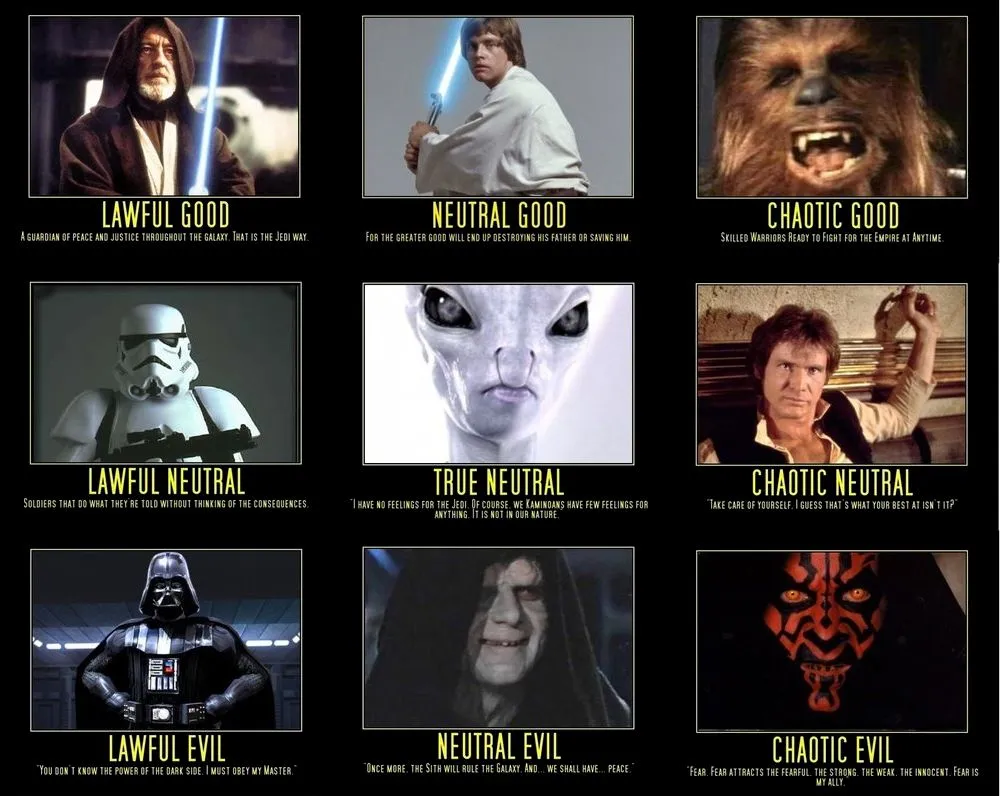
I'm a big fan of personally tests and trying to divine patterns based on certain traits. My Myers-Briggs personality is INTJ, and that seems to fit pretty well. This archetype is often referred to as The Architect or even The Mastermind (in order to cater to our delusions of grandeur).
It's a very rare archetype (2% men, 1% women) and as someone who scored 0% extrovert (100% introvert) on my last test, that makes me extremely rare (if my self-evaluation is to be believed). However, when we do the math, 100% / 16 personalities = 6.25% average, so perhaps 2% isn't as rare as it looks at first glance.
(Introvert, Intuitive, Thinking, Judging) (4-bits)
Unfortunately, I haven't done any research on personality tests in a while, and there have been some significant developments. Maybe later.
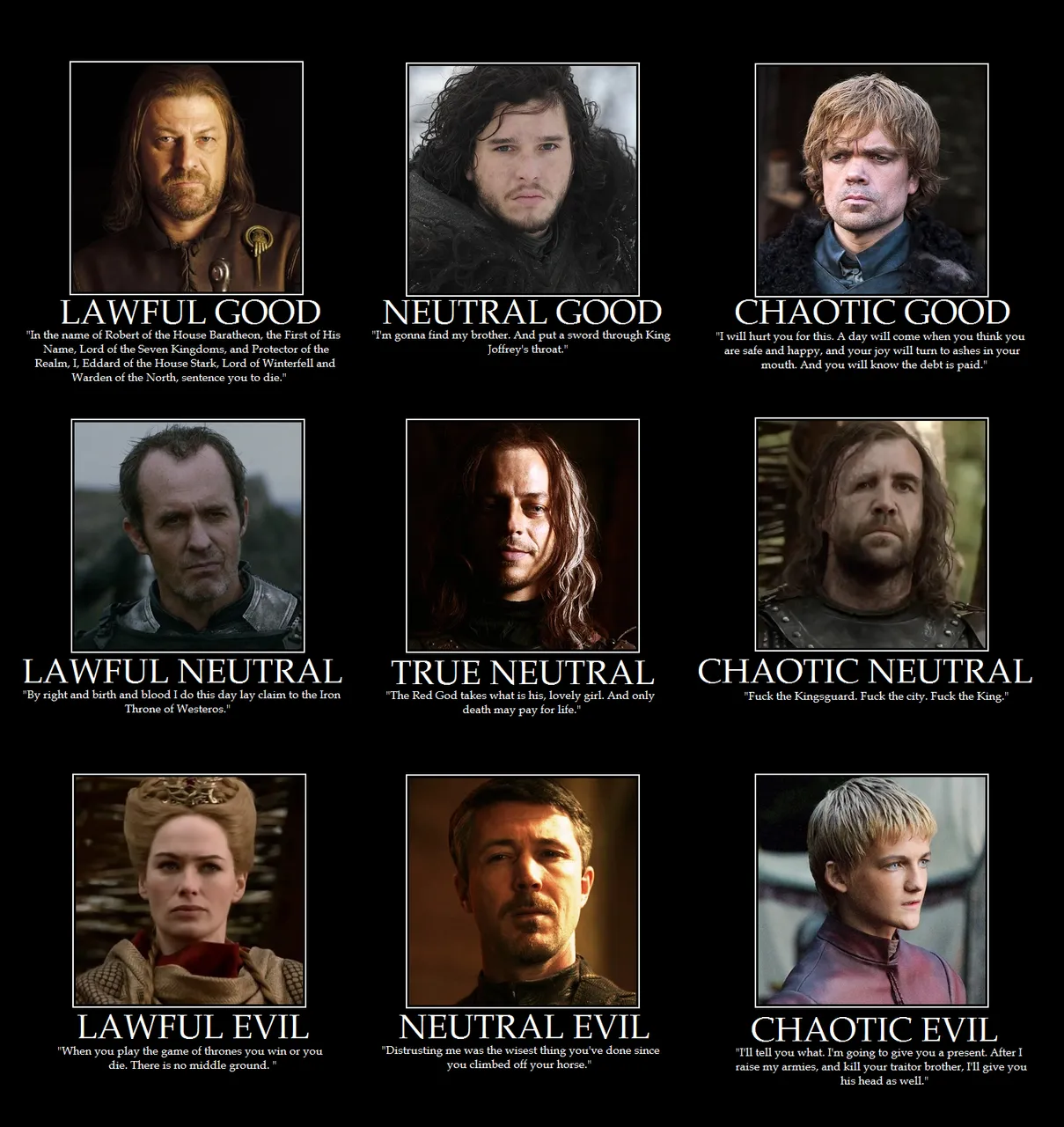
D&D alignment
The lawful/chaotic good/evil personality categories were originally made popular by Dungeons & Dragons (there go gamers again doing their weird gamer things like learning about economics and personality on a scientific level).
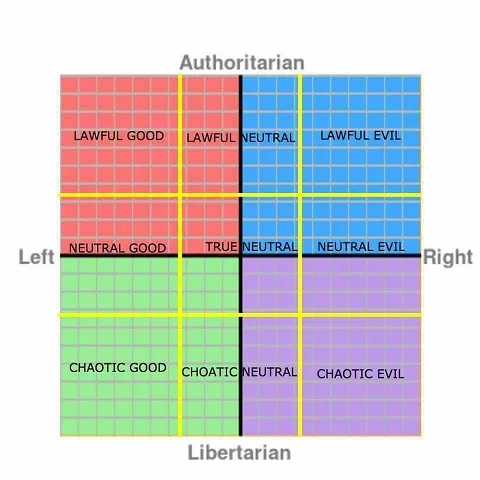
Someone trying to define the right as "evil" and left as "good"... lol.
Liberatian vs Authoritarian is legit though: very accurate.
Personality categories are created by looking at a series of bits and making a new category for every possible option. In Myers-Briggs the bits are introvert/extrovert, intuitive/sensing, thinking/feeling, perceiver/judger. Because it has 4 bits, this creates 2^4 possibilities, for a total of 16 possible personalities within the system. I find the results and conclusions of Myers-Briggs quite interesting.
D&D archetypes
This personality classification only has two bits (lawful/chaotic; good/evil), but they add a third option (neutral), giving the system 9 possible outcomes (3x3) as shown.
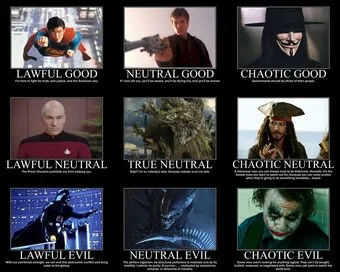
Lawful Good:
As someone who embraces chaos, these people are so boring. Not only do they try to do the right thing all the time and often judge those who don't harshly, but they are also insufferable rule-followers, even if those rules don't make sense in the given context. A paladin holy warrior would be an example of Lawful Good, and it is very possible that they go from righteous to self-righteous and are able to justify some pretty messed up actions based on their own zealous ruleset.
In the Starcraft series, the noble Protoss master-race is essentially able to justify vaporizing entire planets in their fight against the Zerg infestation. Tread carefully, Lawful-Good hypocrites. For the Swarm!
Lawful-Good examples:
- Captain America (Avengers) (Top pick: I love to hate him.)
- RoboCop (IMO most interesting Lawful-Good character because he defies his own programming using his personality)
- Superman (demigod lamer)
- Obi Wan Kenobi (ew)
- Optimus Prime (Transformers) (cool because he's surrounded by chaos and is constantly blowing shit up)
- Ned Stark (please stop being so honorable that you get yourself killed in the most obvious way possible)
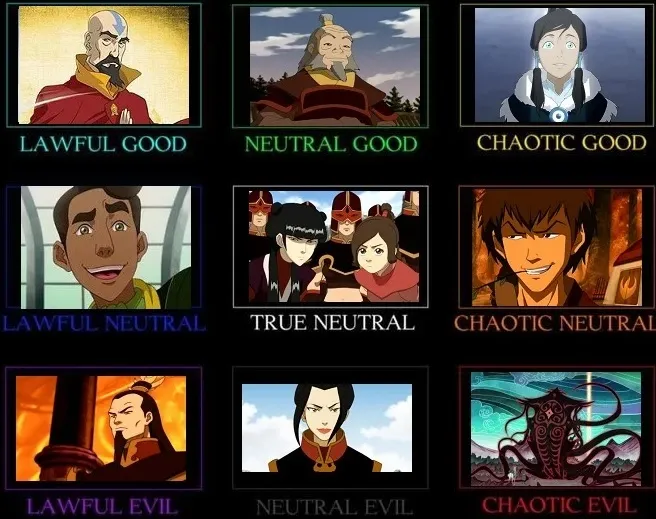
Chaotic Evil:
This is a category that I reserve only for the most heinous of sentient lifeforms. On the other side of the spectrum: the obvious foil of Lawful-Good. Lot's of Chaotic-Neutral and Neutral-Evil characters are misclassified into this group out of sheer dislike.
The chaotic-evil class wants nothing more than to watch the world burn with zero regard for anyone but themselves (and maybe not even that: embracing their own possible destruction as the ultimate display of their chaotic nature).
Chaotic Evil characters have many enemies, and many of their allies are only aligned that way out of sheer terror of being destroyed or enslaved. They are immensely powerful and are likely doomed to be defeated by their own hubris and insatiable thirst for more power: used to dominate the weaker players around them with complete disregard.
Chaotic-evil players are often defined by their willingness to put their own lives up for collateral in order to acquire more power. They put the fear of death into the hearts of all around them, knowing that the cowards and lieutenants they surround themselves by fear them more than anyone else by an exponential margin. They are the ultimate mobsters: classic bad-guy.
Chaotic-Evil Examples:
- The Joker (Batman)
- Voldemort (Harry Potter)
- The Lich (Adventure Time)
- Professor Moriarty (Sherlock Holmes)
- Prince Joffrey (Game of Thrones) (iconic realistic psychopath)
- Freddy Kreuger
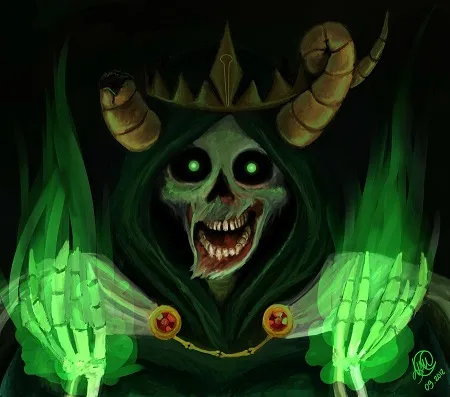
True Neutral (Neutral/Neutral):
True-Neutral characters are the ultimate opportunists. No other classification can so easily go with the flow and align themselves to the winning side of a fight. They are simultaneously an asset and liability to everyone they interact with. Think of an arms dealer who sells weapons to both sides of the war. Hired guns (mercenaries) are also a good example.
Depending on chance, these characters often find themselves in good positioning, but the winds of fate can turn against them in an instant. Double-agents live short lives should both sides decide they've outlived their usefulness. If they create too much chaos the chance of failure is high. The same goes with being too self-serving and greedy (evil). This class walks the razor's edge, and are paid well for the services / measured-risks they incur.
True-Neutral examples:
- The entire Ferengi race in Star Trek.
- Bronn (Game of Thrones)
- Professor Snape (Harry Potter)
- Boba Fett (Star Wars)
- Catwoman (Batman)
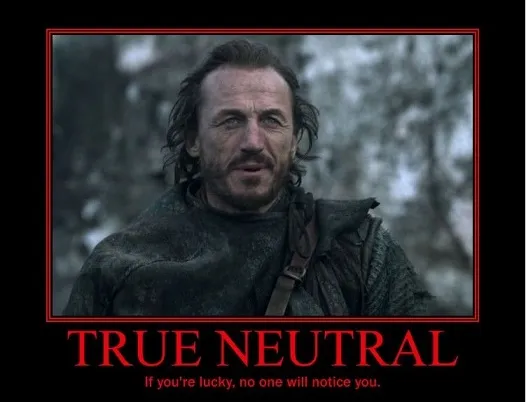
Neutral Good:
These characters try to be lawful but sometimes the rules of society get in the way. Rules are meant to be bent or broken when the context of those rules no longer makes sense. The idea that morals outweigh ethics is an honorable one.
Would you steal food to feed your starving family? Neutral-Goods would do it in a heartbeat without losing a wink of sleep, assuming their theft didn't bring any evil into the world.
These characters are often defined by their struggle to balance their neutral side. Breaking the rules bothers them and navigating the system of morals and ethics is a constant struggle.
Neutral-Good examples:
- Luke Skywalker
- Spiderman
- John Snow
- Captain Malcolm Reynolds (Firefly)
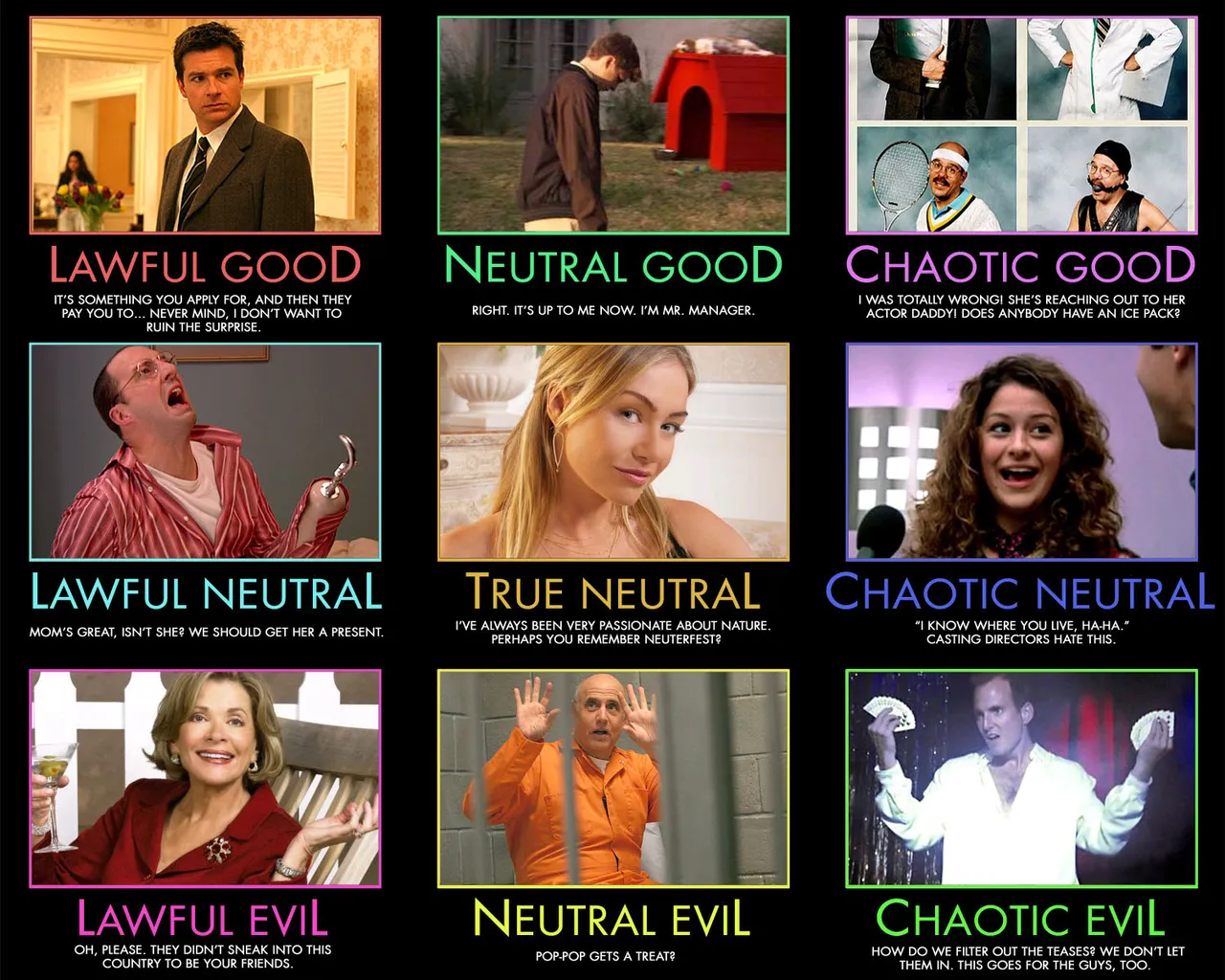
Chaotic Good:
A further extension of Neutral-Good, It is very hard to tell the difference between Chaotic-Good and Neutral-Good characters. It all depends on their environment (societies rules) and how often those rules (ethics) conflict with the character's morals. The more adversity they face, the more chaotic they become.
I personally identify very strongly with chaotic-good alignment. We wanna make an omelet? We better be prepared to break a few eggs. The rules do not matter: because the rules are broken beyond repair.
Chaotic good characters will accomplish great and terrible things. They mean well and their intentions are pure, but their willingness to cross boundaries to accomplish overarching goals is bound to ruffle some feathers and crush some toes. Hopefully, by the time everything is said and done, the ends will justify the means. We take out loans of chaos on credit and hope to pay back more good than the evil we've caused.
Chaotic Good characters often started as neutral-good or even lawful-good in the beginning, but as the fabric of society broke down in front of their very eyes and they learned more about the world: drastic times called for drastic measures.
This is a very risky affiliation, because they will often be rejected by mainstream society. They have a tendency to piss off anyone who identifies with the law in addition to anyone who identifies with evil. It's definitely more important to fight against evil than against law abiding citizens, but sometimes the agents of the Matrix get in the way and they have no choice but to face conflict.
Chaotic-Good examples:
- Batman
- Tyrion Lannister
- Robin Hood
- Han Solo
- Indiana Jones
- Wolverine
- The Doctor (Doctor Who)
- Many many protagonists are chaotic good.
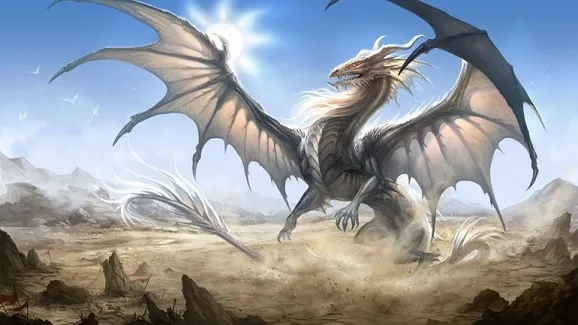
Lawful Neutral:
So boring. Think investment broker. Rule follower. Doesn't care about right and wrong so much about making that money and following the rules in order to not get in trouble.
The Lawful Neutral character will often classify themselves as lawful-good, because they confuse ethics with morals. Because they follow the rules that society puts in place, they believe that trait inherently makes them good people. This allows them to justify the selfish actions they employ that inevitably push them to neutrality.
Outside of the economy, another good example here would be a Judge. Judges think they are Lawful-Good, but they are really Lawful-Neutral. If you broke the law... the law is the law and you will be punished. Doesn't matter if the law is wrong or not.
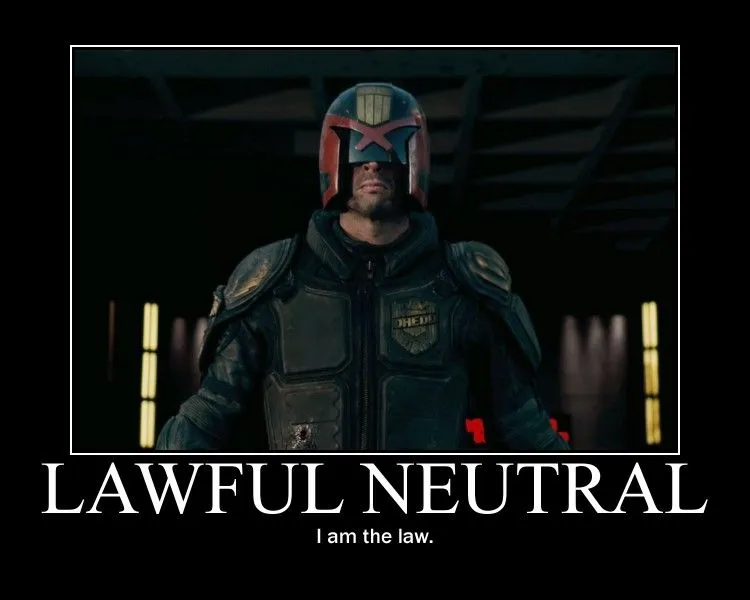
Judge Dred
I'm suddenly reminded of this true-crime documentary I watched where this battered woman was on trial for murdering her husband with a hammer: while he slept. The judge practically begged her to lie and simply tell the court that he was awake and threatening her. Unfortunately, this woman was Lawful-Good and refused to lie, and was determined to take her punishment. The judge knew it was wrong to convict her (probably should have done an insanity thing with expert testimony) but he did it anyway because the law is the law: neutral.
Lawful-Neutral characters are defined by a strict code of ethics/government with little regard for morals or how that code of conduct might affect those outside the system (or even inside it).
Lawful-Neutral examples:
- The entire Predator race.
- The entire Borg race.
- Judge Dred
- Coinbase (aka capitalists that don't break the law)
- Death (the Grim Reaper, particularly as depicted by Terry Pratchett)

Lawful Evil:
While I am clearly heavily biased against lawful characters (because I used to be one as a child), Lawful-Evil people are actually pretty fun. That's because the combination of these two traits is itself a form of chaos. Think central-banker or corrupt defense attorney that gets off on finding loopholes that allow criminals to escape justice. Mr. Potter from It's a Wonderful Life comes to mind.
Lawful-Evil players have immense power within society, and they leverage that power to acquire more and maintain their position within the pyramid. They are the ultimate self-serving capitalists. Again, they are often delusional into thinking they are neutral (or even good) because they follow the rules. The only problem with that is that they are so powerful they often find themselves making the rules. Not a great combination.
However, these characters are extremely predictable. We can always count on them to be selfish and to operate within the systems they've created. This class' greatest weakness is also hubris. They are so powerful and successful that they can't imagine the system imploding out from under them.
Their lack of innovation and cushy life makes them weak. They only know how to battle competitors by buying them out or changing the rules to crush them (regulations). Eventually the systems they build will become so corrupt and inefficient that they are doomed to fail, but if they are lucky it will take several lifetimes for that to happen as they build up their dynasties.
This class is often defined by their immense power and ability to manipulate the law itself to their own ends.
Lawful-Evil examples:
- Captain Hook (strict pirate code/ethics)
- Darth Vader
- Lex Luthor
- Cersei Lannister
- Slumlords
- Corrupt politicians/police/capitalists
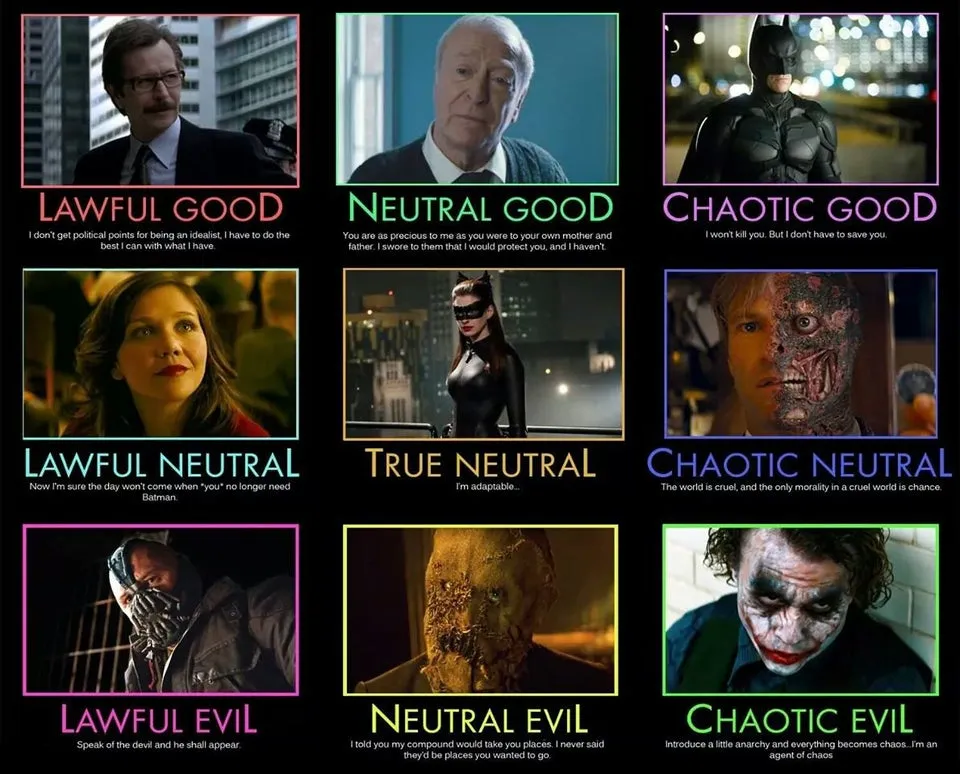
Neutral Evil:
Mostly an extension of the Lawful-Evil class, neutral-evil players are the ones who realized which rules they can break in order to get even farther ahead without getting caught. Like an athlete on steroids, they justify these actions to "stay competitive". Everyone else is doing it, they are just evening the playing field. These people are all about risk vs reward as they try to maximize every possible gain regardless of right and wrong.
These people are natural master manipulators, because they understand the system perfectly and exactly how to exploit it to the fullest.

The main difference between neutral-evil and lawful-evil is that lawful-evil players are often more powerful and already in control of the system. The neutral-evil players strive to take the Iron Throne for themselves by force using any means necessary (incurring more risk). If they accomplish their goals, they will dial it down a bit, hedge their bets, and become lawful-evil players themselves, changing the system's rules to maintain their own power. If they fail... they are usually killed or imprisoned.
On the other side of the coin, neutral-evil players who are willing to be the lapdogs of the establishment are greatly rewarded by the powers that be. Think in terms of corporate CEOs, retail banking, and even entire governments: the keys to power for central-banking. These people are allowed to break the law and the punishment is far less severe than the reward gained. As long as the keys to power do not try to overthrow their lords, everyone is happy (theoretically).
Neutral-Evil examples:
- Littlefinger (Petyr Baelish; Game of Thrones)
- Hannibal Lechter
- Sauron (more interested in power than pure destruction)
- Dr Gaius Baltar (Battlestar Galactica) (sometimes true neutral)
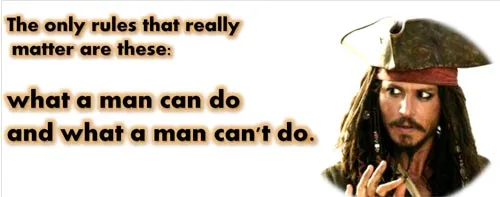
Chaotic Neutral:
Last but certainly not least: chaotic neutral characters are my personal favorite by far. All of the best players are chaotic neutral. Chaotic Good characters such as myself are often jealous of Chaotic Neutral players because the options available to them are limitless: one of the main reasons we transitioned to chaos in the first place.
Who knows, maybe one day I'll make the transition to glorious chaotic neutral. Give me a couple million dollars in crypto and lets do this thing! Fuck around and find out!
On the other hand, Chaotic Good players feel bad when bad things happen, while their Chaotic Neutral counterparts are much more willing to let the chips fall where they may, often taking the path of least resistance to get the job done.
This is my favorite Avengers scene from Ragnarok.
It is so perfectly chaotic-neutral.
So, last time I saw you, you were trying to kill everybody...
Where ya at these days?
It varies from moment to moment...
The look on Bruce Banner's face when Loki says this is absolute gold. It's not very often that one can trust anything a Chaotic-Neutral character says, but in that moment Bruce trusts Loki 100% and knows for a fact that this is the truth, and it legit terrifies him. So good.
One can only be legit Chaotic-Neutral if they're a true sociopath. Not to be confused with psychopath, a sociopath is largely neutral and often serves their own best interests.
In the case of legendary Chaotic-Neutral characters, these people practically get off on the chaos they create, and if anyone tries to classify them as good or evil they will do the opposite simply for that ultimate dopamine hit to balance the scales. Chaos is a drug to these people, and the complete lack of limitations provided by their neutral side gives them more opportunities than any other class.
Chaotic-Neutral characters are defined by their neutral state. Often times they are trying to be more good by either leaning into Chaotic-Good or stopping themselves from going full evil. They are superior candidates for dynamic characterization because nothing is off-limits. Any boundary that they comply with is a testament to their growth and evolution.
Chaotic-Neutral examples:
- Captain Jack Sparrow (tries to be good)
- Q (Star Trek) (tries to not be evil)
- Venom (tries to be good)
- Han Solo (when he's being a dick)
- Loki (tries not to be evil... sometimes)
- Deadpool (tries to be good)
- V (V For Vendetta) (tries to be good)
- Lorne Malvo (Fargo season 1) (worships pure chaos)
"Good? Bad? I'm the guy with the gun."
— Ash Williams, Army of Darkness
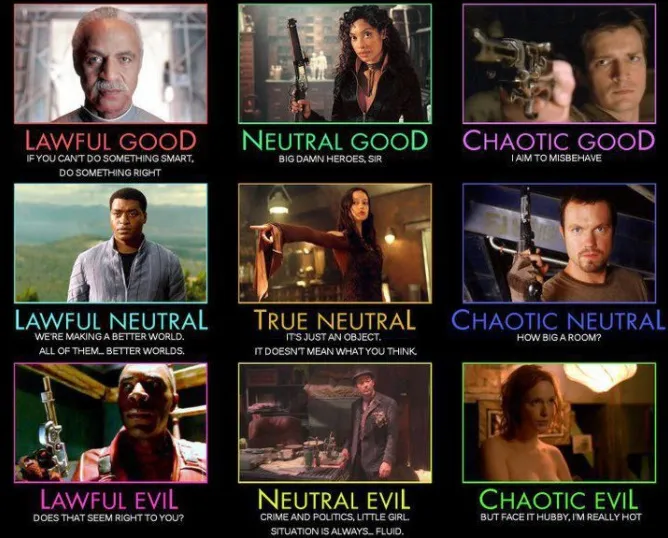
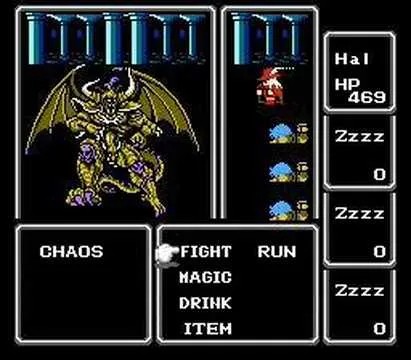
Personal analysis
The goal of chaotic-good players is to eventually defeat chaos, bringing the ethics of society and the morals of the individual into harmony, pushing them back into neutral-good or lawful-good (yuck) territory. Until then, let chaos reign supreme to disrupt the corrupted system in place.
While I personally most identify with chaotic-good: clearly chaotic-neutral is the most fun: completely unrestrained of all ethical or moral constraints, embracing anarchy and casting our flawed definitions of good and evil to the wind. As far as dynamic characterization is concerned, chaotic-neutral characters are the most fun to watch because they have the most room for growth in all directions. In addition, they are completely unpredictable.
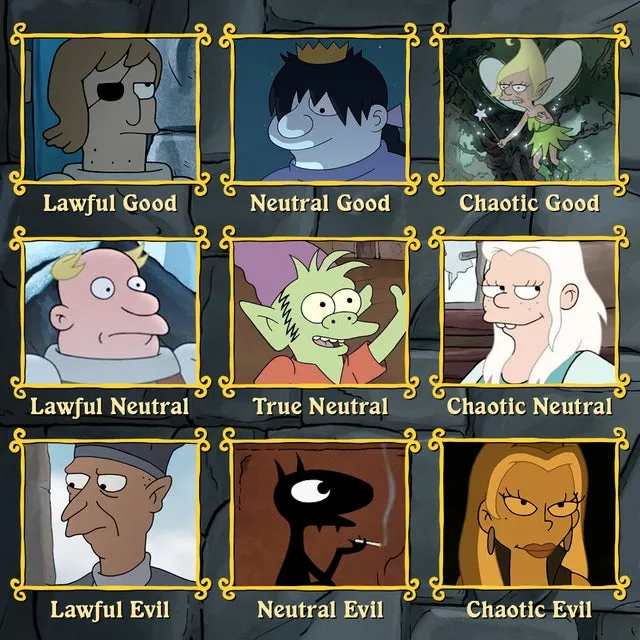
Of course of all these classifications are extremely subjective and up for debate.
As with all personality profiles, there is no one-size-fits all and even classifying characters into these boxes can be extremely difficult. There are many exceptions and arguments to be made, but the results are fascinating nonetheless.
Conclusion
This post ran way too long so I had to break it up into parts. My next post is about the first season of Fargo and legendary iconic chaotic-neutral character Lorne Malvo (zero dynamic movement). Chaotic Neutral characters get shit done, son!
I think I may have talked about Myers-Briggs in the past, but that would have been years ago. It may be time for a refresher course in the days ahead. There is also another personality system that I was previously embarrassed to talk about because it is a PUA (pickup artist) system. Interesting nonetheless. There's a lot to talk about. I'll get around to it eventually.

